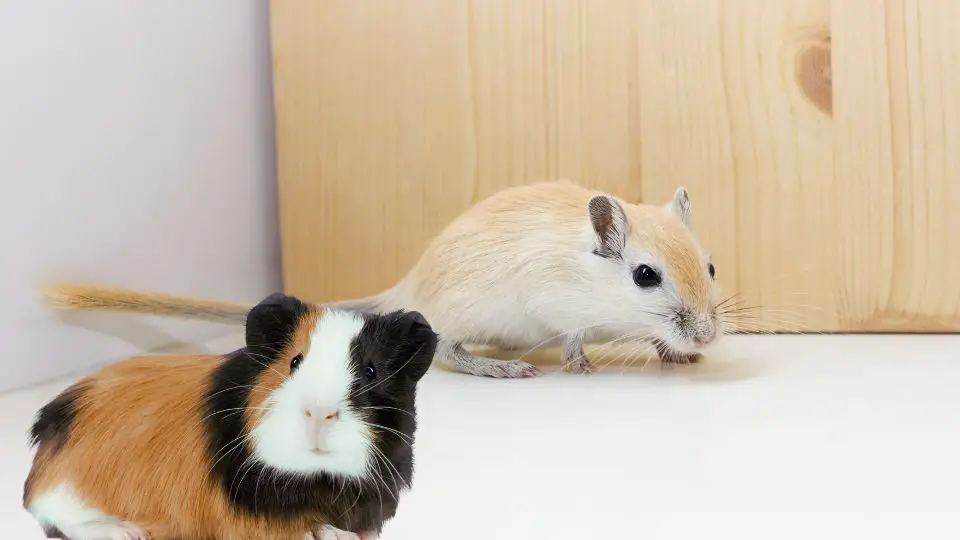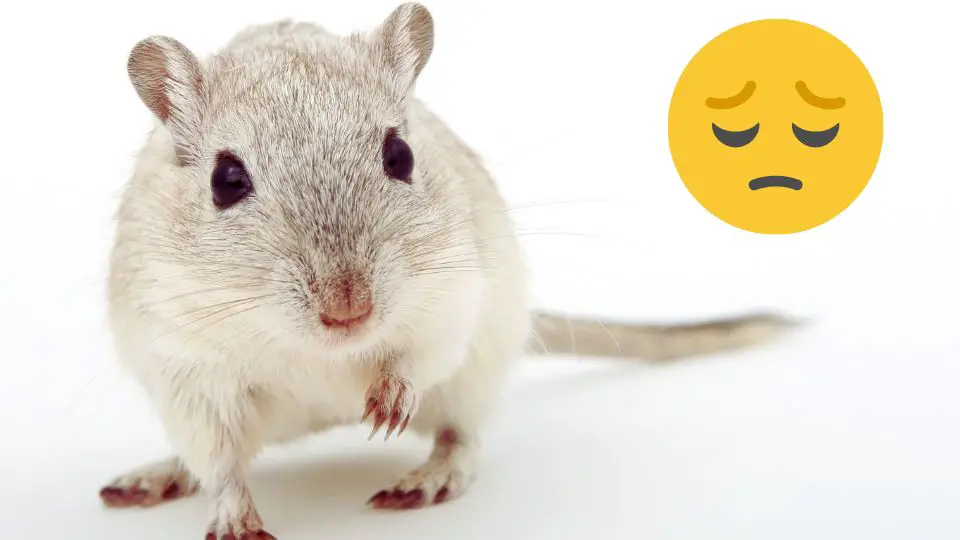Gerbils are curious and agile creatures known for their hiding and burrowing instincts. If given the opportunity, they may explore various nooks and crannies of your house, seeking shelter and security.
Gerbils may hide in various places in a house, such as behind furniture or appliances, inside cardboard boxes or tubes, underneath or inside bedding material, and in small gaps or crevices.
Understanding their hiding preferences can help you locate them if they manage to escape their enclosure. Let’s explore some common places where gerbils may hide in a house.
Typical Hiding Places
Gerbils are naturally curious and resourceful animals, always on the lookout for safe and cozy hiding spots in their environment. If you have a gerbil in your house, you have to be aware of the typical hiding places they may seek. Understanding these hiding spots can help you locate your gerbil if it goes missing or provide additional hiding options to make their habitat more engaging.
Here are the most common areas where gerbils may hide in a house:
Behind furniture or appliances
Behind furniture or appliances, such as bookshelves, cabinets, or large appliances like refrigerators or washing machines, are common hiding places for gerbils. These areas provide a combination of darkness, security, and warmth that gerbils naturally seek out.
Gerbils are skilled climbers and can navigate their way to the back of furniture or appliances using their sharp claws and agile bodies. They may squeeze through narrow gaps or climb up the sides to find a cozy spot where they feel safe and hidden from view.
When moving or rearranging furniture or appliances, you should exercise caution and be mindful of the possibility that a gerbil may be hiding in these areas. Before making any changes, take the time to carefully inspect the surroundings and listen for any signs of movement. Avoid sudden or loud noises that could startle the gerbil and cause it to retreat further into its hiding spot.
To prevent your small pet from accessing these areas in the first place, consider using barriers or coverings to block off any openings or gaps behind furniture or appliances. This can help create a safe and controlled environment for your gerbil while also making it easier for you to monitor their whereabouts.
Inside cardboard boxes or tubes
Inside cardboard boxes or tubes is another favorite hiding spot for gerbils. These small, enclosed spaces provide a sense of security and privacy that gerbils naturally seek. Cardboard boxes, tubes, or tunnels can serve as temporary hiding places or even become permanent homes for gerbils.
Gerbils have a natural instinct to burrow and create tunnels, and cardboard materials provide them with an opportunity to engage in this behavior. They may chew on the cardboard to create openings or modify the shape of the boxes and tubes to suit their preferences.
You may find your small pet darting into a cardboard box or disappearing into a tube as a form of play or a way to retreat from external stimuli. You should provide a variety of cardboard boxes and tubes of different sizes to cater to their nesting and hiding needs.
Keep in mind that gerbils may also chew on the cardboard, which is a normal behavior for them. This can help keep their teeth trimmed and healthy. However, be cautious if you notice excessive chewing or ingestion of cardboard, as this could lead to digestive issues. Monitor their behavior and consult a veterinarian if you have any concerns.
Underneath or inside bedding material
Underneath or inside bedding material is another common hiding place for gerbils. Gerbils are natural burrowers and enjoy creating intricate tunnel systems within their bedding. If you provide them with loose substrate or bedding material in their cage, they will likely use it as an opportunity to dig and create hidden chambers.
Gerbils will often burrow deep into their bedding, making it difficult to spot them from the surface. They may also create multiple entrances and exits to their tunnels, allowing them to move around and explore their hidden domain.
The bedding material not only serves as a hiding place but also provides insulation and comfort for gerbils. It mimics their natural habitat where they would burrow in sand or soil to regulate their body temperature and create a safe space.
Regularly inspect the bedding to ensure it remains clean and free from any contaminants. Remove any soiled or wet areas to maintain a hygienic environment for your gerbils. Replace the bedding completely as needed to prevent the buildup of odors or bacteria.
In small gaps or crevices
In small gaps or crevices is yet another place where gerbils may choose to hide in a house. Gerbils have flexible bodies that enable them to squeeze through narrow openings that may seem impossible for their size. They are natural explorers and are often attracted to small gaps or crevices as potential hiding spots.
Gaps or crevices can include spaces between furniture and walls, behind baseboards, or even within the structure of the house itself. Gerbils may enter these areas out of curiosity or in search of a safe and secluded place to retreat to.
It’s essential to ensure that these small gaps and crevices are blocked off or made inaccessible to gerbils. Seal any openings in walls or baseboards to prevent gerbils from entering areas where they can get stuck or lost. Securely attach furniture to the walls or block off any gaps behind or underneath them.
Other possible hiding places
Here are some additional possible hiding places where gerbils may seek refuge:
- Inside or underneath bookshelves or cabinets
- Behind curtains or drapes
- Inside shoes or slippers left on the floor
- Within the folds of curtains or blankets
- Inside or behind decorative objects, such as vases or plant pots
- Behind or inside stuffed animals or toys
- Within cluttered or disorganized areas, such as piles of clothing or papers
- Behind wall-mounted artwork or picture frames
- Within the branches or leaves of artificial plants
- Inside or behind appliances with exposed wiring, such as televisions or computer monitors (take precautions to ensure their safety around electrical equipment)
How To Find An Escaped Gerbil
Discovering that your gerbil has escaped from its enclosure can be a stressful experience. However, with a calm and systematic approach, you can increase your chances of finding your escaped gerbil safely.
Secure the Room
Start by securing the room where the gerbil was last seen. Close all doors and windows to prevent the gerbil from venturing further. Block any small gaps or openings that the gerbil could potentially hide in. Remember, gerbils are excellent climbers, so be thorough in checking for any potential escape routes.
Create a Safe Environment
Make the room as enticing and safe as possible to encourage the gerbil to come out of hiding. Place its familiar bedding, food, and water near the enclosure or in areas where you suspect it may be hiding. Avoid using any scented items or strong odors that could scare or confuse the gerbil.
Use Food Trails and Bait
Set up food trails leading back to the gerbil’s enclosure or a humane trap. Gerbils have a keen sense of smell, so leaving a trail of their favorite treats can entice them to follow it back to safety. Place treats strategically along the trail, gradually leading closer to the enclosure.
Use Hide Boxes
Place small hide boxes or shelters in various locations around the room. Gerbils may seek out enclosed spaces for safety and shelter. These hide boxes can be enticing places for them to take refuge while you work on finding them.
Stay Quiet and Patient
Gerbils are generally more active during the night, so dimming the lights and keeping the room quiet can help create a calm environment. Avoid making sudden loud noises or movements that could scare the gerbil away. Keep a watchful eye and be patient, as it may take some time for the gerbil to feel comfortable enough to come out of hiding.
Check High and Low
Gerbils are known for their climbing and burrowing abilities. Check both high and low areas in the room, including shelves, behind furniture, under carpets, and within any potential hiding spots you identified earlier. Take extra care when checking electrical appliances or areas with potential hazards.
Seek Assistance
If you are unable to find your gerbil after thorough searching and efforts, consider seeking assistance from family members, friends, or even professional pest control services. They may have experience in locating small animals or access to specialized equipment.
How To Catch An Escaped Gerbil
Here are some helpful tips and techniques on how to catch an escaped gerbil.
Remain Calm and Observant
The first step is to stay calm and observe the gerbil’s behavior. Gerbils are naturally curious but may be cautious when in unfamiliar territory. Keep an eye on its movements and try to anticipate its next actions.
Secure the Area
Close all doors and windows to prevent the gerbil from escaping further. Block any small gaps or openings that the gerbil could potentially squeeze through. Remove any potential hazards or toxic substances from the area to ensure the gerbil’s safety.
Create a Safe Zone
Designate a safe area for the gerbil to explore, such as a bathroom or a small enclosed room. Remove any items that could be dangerous or difficult to retrieve, such as electrical cords or fragile objects. Make sure the space is gerbil-proofed and escape-proof.
Use Tempting Bait
Place enticing treats or the gerbil’s favorite food in a secure and easily accessible spot within the designated area. Gerbils have a keen sense of smell and will be drawn to the scent of their favorite treats. This can help lure the gerbil closer to you.
Set up a Trap
Consider using a humane trap to capture the gerbil. These traps are designed to catch small animals without causing harm. Place the trap near the bait and ensure it is set up correctly according to the manufacturer’s instructions. Check the trap regularly to avoid causing unnecessary stress to the gerbil.
Use Gentle Hands
If the gerbil is in an open area, you may attempt to catch it with your hands. Approach slowly and with gentle movements to avoid startling the gerbil. Use both hands to create a cupped shape and carefully scoop the gerbil into your hands. Be patient and persistent, as gerbils are fast and may try to evade capture.
Safe and Secure Hiding Options
Providing safe and secure hiding options is essential to meet their instinctual needs and promote their overall well-being. Here are our recommended tips to offer a safe spot for your little pet:
Escape-Proof and Pet-Safe
When selecting hiding spots for gerbils, it is crucial to ensure they are escape-proof and inaccessible to other pets or potential hazards. Gerbils are skilled climbers and can squeeze through small openings. Avoid using materials or containers with gaps or holes that the gerbil could get stuck in or escape from. Opt for solid, sturdy hiding options that can withstand the gerbil’s exploration.
Avoiding Toxic Materials
Make sure the hiding spots you provide do not contain any toxic materials or substances. Gerbils may chew on their surroundings, and ingesting toxic substances can be harmful or even fatal to them. Avoid using hiding spots made of materials treated with chemicals or paints. Stick to natural, non-toxic materials such as wood or ceramic.
Multiple Hiding Options
Gerbils have individual preferences when it comes to hiding. Some may prefer enclosed spaces, while others may favor open hideouts. Providing a variety of hiding options accommodates their diverse needs and allows them to choose what makes them feel most secure. Consider offering hideouts such as tunnels, small caves, wooden houses, or even purpose-made gerbil hideaways available in pet stores.
Placement and Accessibility
Place the hiding spots strategically throughout the gerbil’s enclosure to encourage exploration and utilization. Ensure they are easily accessible and located in different areas of the cage. This allows the gerbil to feel secure and have a hiding spot nearby, regardless of where they are in their habitat. Avoid overcrowding the cage with too many hiding options, as gerbils also need space for other activities.
Observe Gerbil Behavior
Observe your gerbil’s behavior to determine their preferred hiding spots. They may show a preference for specific hideouts by frequenting them more often. Pay attention to their body language and signs of comfort or distress when using certain hiding spots. This observation will help you understand which hiding options they find most appealing and adjust their environment accordingly.
FAQ
Do gerbils like to hide?
Yes, gerbils naturally enjoy hiding. It is an instinctual behavior that helps them feel secure and safe. Providing appropriate hiding spots in their enclosure allows them to engage in this natural behavior.
What attracts gerbils?
Gerbils are attracted to various stimuli in their environment. They are particularly drawn to places where they can find food, water, and nesting materials. They also enjoy exploring tunnels, tubes, and toys that provide mental and physical stimulation.
Do gerbils come back?
Gerbils have a strong homing instinct, and they will often return to their cage if they manage to escape. However, there is no guarantee that a gerbil will come back on its own. It is crucial to take immediate action to locate and safely capture an escaped gerbil to prevent it from getting lost or encountering potential dangers.
Why are my gerbils hiding?
There can be several reasons why gerbils are hiding. It could be due to feeling anxious, scared, or stressed. They may be hiding to seek a sense of security or to retreat from perceived threats or disturbances. It is essential to assess their environment for any potential stressors and ensure they have appropriate hiding spots available to them. If the hiding behavior persists or is accompanied by other signs of illness or distress, it is advisable to consult with a veterinarian.
Conclusion
Gerbils have a natural inclination to find hiding spots where they can feel safe and secure. It’s important to be aware of their potential hiding places to ensure their well-being and prevent them from getting lost or encountering harm.
By being vigilant, providing appropriate hiding options in their enclosure, and taking prompt action if they escape, you can create a safe and enjoyable environment for your gerbil companions.







